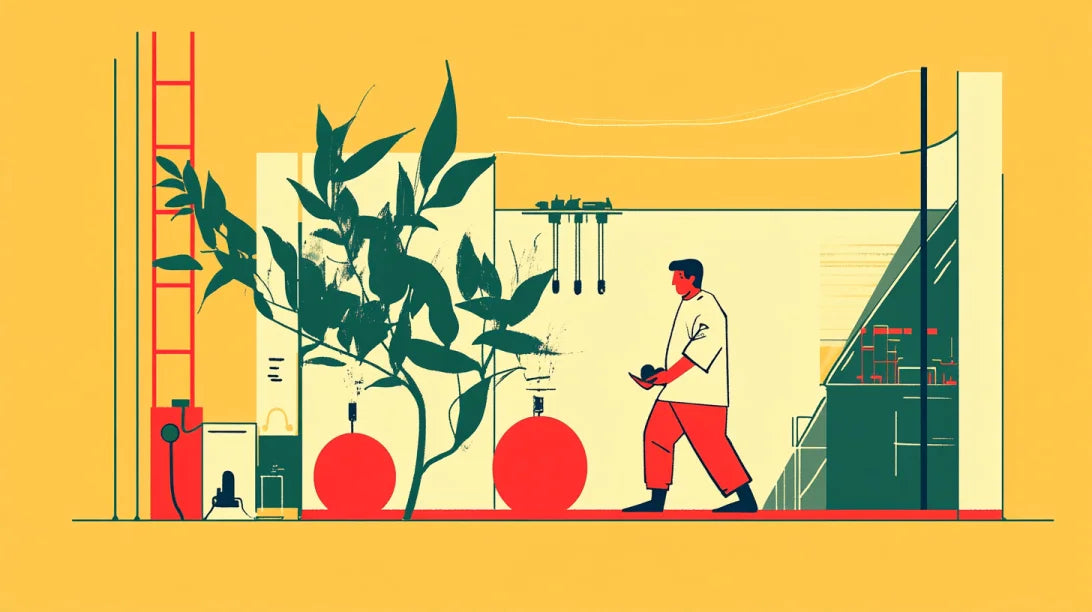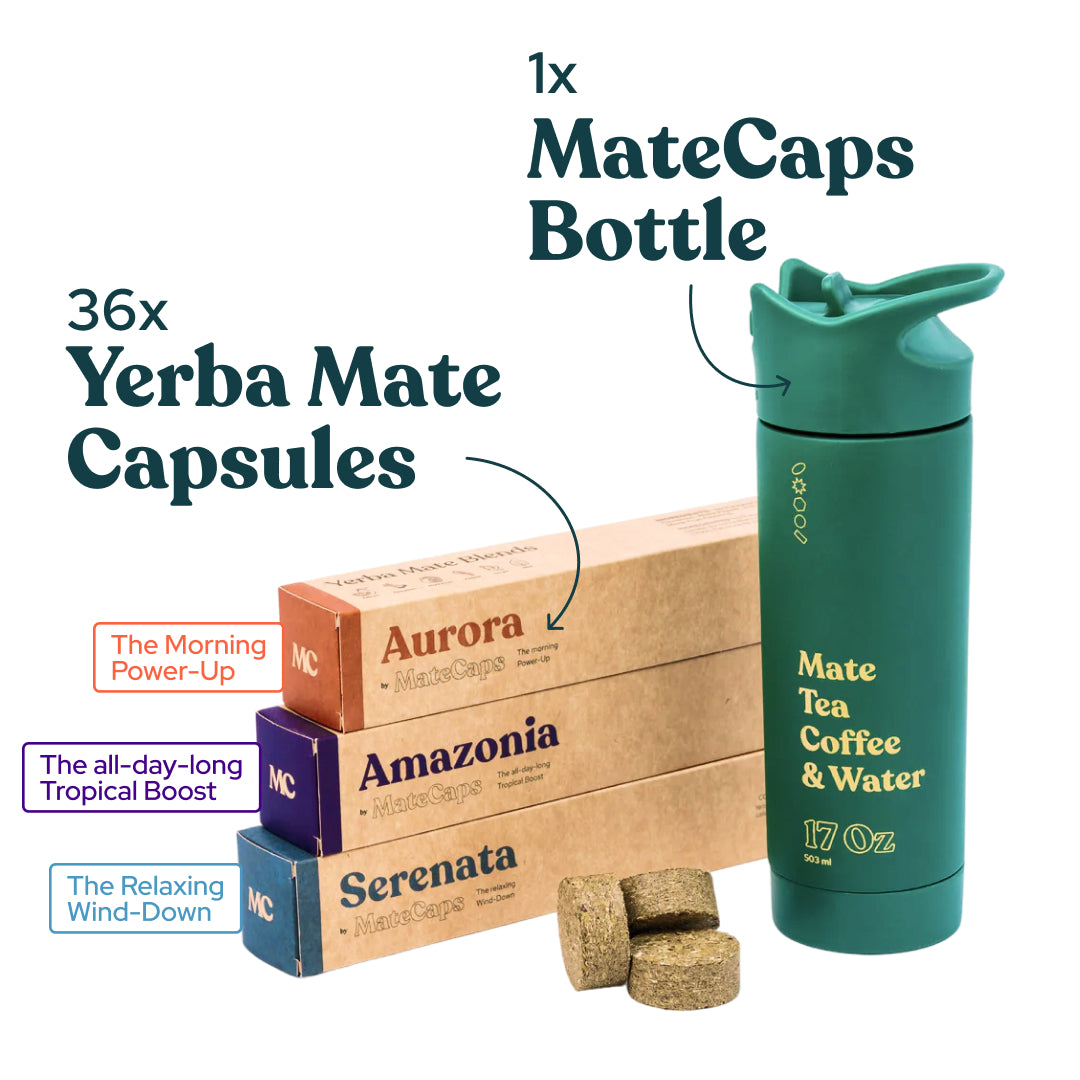
Yerba Mate Cold Brew: Guide & Recipes
Start your day calm and focused. Yerba mate cold brew delivers steady energy without the jitters. It's smooth, less bitter than hot infusions, and easy to prepare. This guide walks you through benefits, methods, recipes, storage, and science-backed facts. ☀️🍃
Why choose yerba mate cold brew?
Cold-brewed yerba mate offers a different flavor and experience than hot mate. Cold brewing extracts fewer bitter compounds and more of the delicate, sweet, earthy notes. The result is a clean, mellow cup that many people prefer for daily drinking. 😌
- Milder taste — less astringency than hot mate.
- Longer extraction window — you can brew overnight for convenience.
- Versatile — drink straight, over ice, or as a concentrate for blends.
Research into cold extraction methods shows that cold concentrates can preserve bioactive compounds and antioxidants in plant extracts, offering beneficial activity without excessive heat-related changes, according to a scientific analysis of cold-brew techniques and extracts published study.
The science: antioxidants, caffeine, and more
Yerba mate contains polyphenols, xanthines (including caffeine), and saponins. Cold brewing influences which compounds appear in the final drink.
- A peer-reviewed analysis of cold extract methods found that cold preparations can retain antioxidant and antiviral activities in plant extracts, depending on technique and time see the study.
- Cold brew typically reduces perceived bitterness and acidity. This can make antioxidant-rich compounds more palatable.
For context on yerba mate’s broader health profile, plant-based health resources summarize its energizing effects and nutritional highlights Fusion Teas review. They highlight yerba mate’s potential to support alertness and provide vitamins and minerals common to leaves of Ilex paraguariensis.
Flavor profile and what to expect
Cold-brewed mate tastes:
- Earthy and grassy — like green tea, but fuller.
- Sweet undertones — especially when brewed longer.
- Less bitter — a big advantage for new mates drinkers.
Try it plain first. Then add citrus, mint, or a splash of unsweetened almond milk. Small tweaks change the profile dramatically.
Basic recipes: Easy cold brew methods
Below are three practical methods: mason jar, French press, and quick concentrate. Each gives reliable results.
Mason jar (overnight cold brew)
- 4 tablespoons loose yerba mate (about 10–12 g).
- 1 quart (1 L) cold filtered water.
- Combine leaves and water in a mason jar.
- Stir, seal, and refrigerate 8–12 hours.
- Strain through a fine mesh or coffee filter.
Result: Smooth, ready-to-drink brew. Keeps 3–4 days refrigerated.
French press (fast and efficient)
- 3 tablespoons loose yerba mate per 16 oz (500 mL).
- Add cold water and refrigerate 6–8 hours.
- Press gently and pour.
Result: Minimal fuss, easy straining.
Cold concentrate (strong, versatile)
- 1 cup (80–100 g) yerba mate to 1 quart (1 L) water.
- Refrigerate 12–18 hours.
- Strain; dilute 1:1 or 1:2 with water or sparkling water.
Use concentrates in cocktails and mocktails, or dilute for a quick iced cup.
For variations and inspiration, see practical recipes and iced mate techniques at MyTastyCurry’s yerba mate recipe collection.
Ratios, time, and temperature (practical tips)
Small changes make big differences.
- Ratio basics: 1–4 tablespoons per quart (0.25–1 g/mL). Adjust by taste.
- Steep time: 6–18 hours. More time = fuller flavor.
- Temperature: always use cold or room-temperature water for true cold brew.
- Grind/leaf size: use loose leaves or coarse cut. Finer powders (like tereré mates) can cloud more and require finer filtration.
Pro tip: Start with a middle ground—4 tablespoons per quart, 10 hours. Adjust after your first batch.
Avoiding bitterness and cloudiness
- Don’t use hot water. Heat extracts bitter tannins.
- Use filtered water for a cleaner taste.
- Strain well: repeat straining if cloudy.
- If too bitter, cut with water or citrus.
Caffeine content compared to coffee and tea
Yerba mate’s caffeine varies by leaf cut and steeping. Cold brewing extracts caffeine, but generally offers a steady, moderate caffeine release. Consumer guides and beverage trend articles list yerba mate among popular caffeinated options for focused energy without spikes (Interfresh’s 2025 caffeinated drinks guide).
Typical ranges (approximate):
- Cold brewed yerba mate (8 oz): 30–70 mg.
- Brewed coffee (8 oz): 95–165 mg.
- Black tea (8 oz): 40–70 mg.
Your actual caffeine depends on leaf amount, steep time, and dilution.
Cold brew yerba mate as part of your routine
Many people swap coffee for mate because it offers energy with fewer jitters. Mate can be consumed:
- In the morning for focus.
- Mid-afternoon to avoid late-night sleep disruption.
- As a pre-workout sip for steady alertness.
Industry reports show a rise in ready-to-drink yerba mate products for consumers seeking quick alternatives to coffee, showing mainstream interest in the beverage's convenience and profile industry launch coverage.
Flavor-boosting add-ins (clean & simple)
- Fresh mint leaves — cooling and refreshing. 🌿
- Citrus slices — brighten the cup. 🍋
- A dash of cinnamon or vanilla — warms the flavor.
- Sparkling water — for a sparkling mate spritzer. ✨
Avoid sugary syrups if you want a clean energy drink. Use natural sweeteners sparingly.
Equipment and sustainability notes
Minimal gear is required:
- Mason jar or pitcher.
- Fine mesh strainer or cheesecloth.
- French press (optional).
Choose loose-leaf mate sourced from certified producers where possible. Sustainable harvesting and fair-labor practices matter. For packaged options, look for transparent sourcing statements.
Troubleshooting common issues
- Too weak? Use more leaves or increase steep time.
- Too strong or bitter? Dilute and shorten your next brew.
- Cloudy? Try finer straining and let it settle before pouring.
- Rapid flavor loss? Store in airtight containers and keep refrigerated.
Creative uses for cold-brew mate
- Iced lattes: cold mate + cold milk alternative.
- Mocktails: mate, lime, and a touch of bitters.
- Smoothies: use mate instead of plain water for a nutrient boost.
- Cooking: poach fruit in cold mate infusions for subtle flavor.
Testimonials & Social Proof
"I swapped my afternoon coffee for cold-brew mate. No crash, just steady focus." — Jamie, remote designer

"The smoothness surprised me. I brew a big jar and sip all week." — Priya, teacher

These real-user snapshots reflect common experiences: reduced jitters, sustained focus, and a simple routine.
Safety and interactions
Yerba mate contains caffeine and plant compounds that may interact with medications or conditions. If you have hypertension, are pregnant, or take medications, consult a healthcare professional. General moderation is advised—aim for a sensible daily intake.
Ready-to-drink vs. homemade cold brew
The market now includes RTD (ready-to-drink) yerba mate beverages, giving consumers convenience with consistent flavor profiles. Industry notes highlight notable product launches that bring organic, brewed mate to shelves for quick consumption DairyFoods coverage.
Homemade cold brew wins on control: you choose leaf, water, and strength. RTD wins on time. Both have places depending on lifestyle.
Final tips for great batches every time
- Use fresh leaves.
- Keep it cold and filtered.
- Taste as you go and take notes.
- Store in glass when possible.
Further reading and resources
- Practical recipes and iced mate methods: MyTastyCurry yerba mate recipes.
- Health context and benefits overview: Fusion Teas on yerba mate.
- Caffeine and beverage trends: Interfresh caffeinated drinks guide.
- Industry product launches: DairyFoods article on RTD yerba mate.
- Cold extraction science: peer-reviewed analysis of cold concentrates and extracts PMC study.
Conclusion: Where cold-brew mate fits—and a helpful resource
Yerba mate cold brew is a gentle, versatile way to enjoy natural, sustained energy. It’s simple to make, adaptable to taste, and increasingly visible in mainstream drink options. If you value convenience and consistent portions, consider measured formats and portioned products that make daily brewing simpler. For more information on portioned yerba mate and convenient delivery formats, see MateCaps, which offers an approach to consistent servings and easier preparation: https://matecaps.com.
Enjoy your next jar of mate—smooth, chilled, and focused. 🍃✨
Frequently Asked Questions
How long should I cold brew yerba mate for the best flavor?
For balanced flavor, aim for 8–12 hours in the refrigerator. Shorter times (6–8 hours) yield a lighter cup, while longer times (12–18 hours) create a fuller, sweeter profile. Use the 8–12 hour range as your starting point and adjust based on taste. If you prefer a concentrate, brew closer to 12–18 hours and dilute before serving. Always use filtered water and a coarse-leaf yerba mate to reduce cloudiness and bitterness.
What is the caffeine level in cold-brewed yerba mate compared to coffee?
Cold-brewed yerba mate typically contains about 30–70 mg of caffeine per 8 oz serving, though this varies by leaf, amount, and steep time. Brewed coffee commonly has 95–165 mg per 8 oz. Yerba mate tends to provide a steadier, more sustained energy release with less of a spike-and-crash profile for many people. Exact caffeine content depends on your chosen ratio and steep duration.
Can I use tea bags or loose leaf mate for cold brew?
Both tea bags and loose-leaf yerba mate work for cold brew. Loose-leaf generally gives fuller flavor and is easier to strain. Tea bags are convenient but may contain finer particles that increase cloudiness and require more filtration. If using bags, try two per quart and extend steep time slightly. For best results and control over strength, many home brewers prefer loose leaf.
How should I store cold-brewed yerba mate, and how long will it keep?
Store cold-brewed yerba mate in an airtight glass container in the refrigerator. Properly stored, it stays fresh for 3–4 days. If the brew smells off or tastes noticeably different, discard it. For concentrates, refrigeration extends usability slightly, but use within a week for best flavor. Avoid metal containers that can impart flavors; glass is preferred.
Does cold-brew preserve antioxidants in yerba mate?
Cold-brew methods can preserve antioxidant compounds in plant extracts, and some studies show cold concentrates retain antioxidant and antiviral activities depending on extraction method and time. Cold extraction tends to reduce harsh tannins while preserving delicate polyphenols, which may make the antioxidant profile more palatable. For deeper context, see peer-reviewed analyses of cold extract techniques and their effects on bioactive compounds.
What are easy flavor variations for cold-brew yerba mate?
Simple add-ins transform your cold brew: fresh mint leaves for cooling notes, citrus slices like lemon or orange to brighten flavors, a dash of cinnamon for warmth, or sparkling water for an effervescent spritzer. Use natural, low-sugar options if you want to keep the drink clean and maintain steady energy. Start plain, then experiment with small additions to find your preferred profile.
